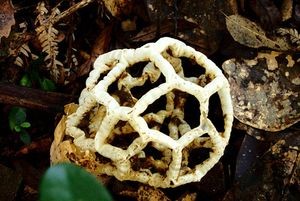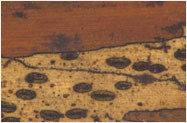 Ileodictyon cibarium (basket fungus, saprobic, and foul-smelling). Photo: Andre Goble.Fungi are everywhere, and affect us in many ways. They are one of the most numerous groups of organisms in New Zealand, and globally. There are an estimated 1.5 million species of fungi worldwide, and an expected 22,000 species in New Zealand. To date, approximately 7,500 species have been recorded in New Zealand, accounting for about a third of our total fungal biota.
Ileodictyon cibarium (basket fungus, saprobic, and foul-smelling). Photo: Andre Goble.Fungi are everywhere, and affect us in many ways. They are one of the most numerous groups of organisms in New Zealand, and globally. There are an estimated 1.5 million species of fungi worldwide, and an expected 22,000 species in New Zealand. To date, approximately 7,500 species have been recorded in New Zealand, accounting for about a third of our total fungal biota.
Fungi occur on land, in soil, in fresh water and the sea, and in the air. They are associated with almost all forms of life. Most fungi feed and grow as either a spreading network of tube-like hyphae (mycelium) or as unicellular budding cells (yeasts). The cell wall is composed largely of the polysaccharide chitin, and hyphal growth occurs at the tip by fusion of vesicles with the wall. Macroscopic reproductive structures such as mushrooms consist of precisely aggregated hyphae, although only a minority of fungi produces these; most species are microscopic in both their vegetative and reproductive forms.
 Lophodermium richaeae on Dracophyllum pyrimidale - microfungus and parasite. Photo: Peter Johnston.Fungi spread by sexual and/or asexual spores that may be produced in very large numbers. The two largest groups of fungi are the sexually reproducing ascomycetes (including the cup fungi, many leafspot fungi, yeasts) and basidiomycetes (including mushrooms, brackets, puffballs, rusts). Ascospores of the ascomycetes are produced inside a sac-like structure, the ascus, while the basidiomycetes produce basidiospores on the outside of a special cell called a basidium. Fungal life cycles vary from those with complex sexual cycles, with multiple mating types and spore stages, to others that have dispensed with sex altogether and have evolved asexually.
Lophodermium richaeae on Dracophyllum pyrimidale - microfungus and parasite. Photo: Peter Johnston.Fungi spread by sexual and/or asexual spores that may be produced in very large numbers. The two largest groups of fungi are the sexually reproducing ascomycetes (including the cup fungi, many leafspot fungi, yeasts) and basidiomycetes (including mushrooms, brackets, puffballs, rusts). Ascospores of the ascomycetes are produced inside a sac-like structure, the ascus, while the basidiomycetes produce basidiospores on the outside of a special cell called a basidium. Fungal life cycles vary from those with complex sexual cycles, with multiple mating types and spore stages, to others that have dispensed with sex altogether and have evolved asexually.
All fungi are heterotrophic and cannot photosynthesise. Fungi feed either saprobically on dead organic matter or symbiotically in association with living cells of other organisms. Symbiotic associations may be mutually beneficial (mutualistic, e.g. lichens, mycorrhizas), apparently not harmful to either partner (commensalistic, e.g. endophytes within living plant tissues), or harmful to the host partner (parasitic, e.g. on animals, plants or even other fungi).
Lichens are a nutritional grouping comprising partnerships between a fungus and an alga, with the fungal component providing the formal name for the lichen. Almost 20% of fungal species form lichens. Beneficial mycorrhizal associations of fungi with plant roots are the norm for most plant species, and are one of the keys to the evolutionary success of the land plants. Fossil evidence supports a concurrent migration of both fungi and plants from sea to land around 460 million years ago.
For more information see:
https://nzfungi2.landcareresearch.co.nz/
https://www.landcareresearch.co.nz/tools-and-resources/identification/
